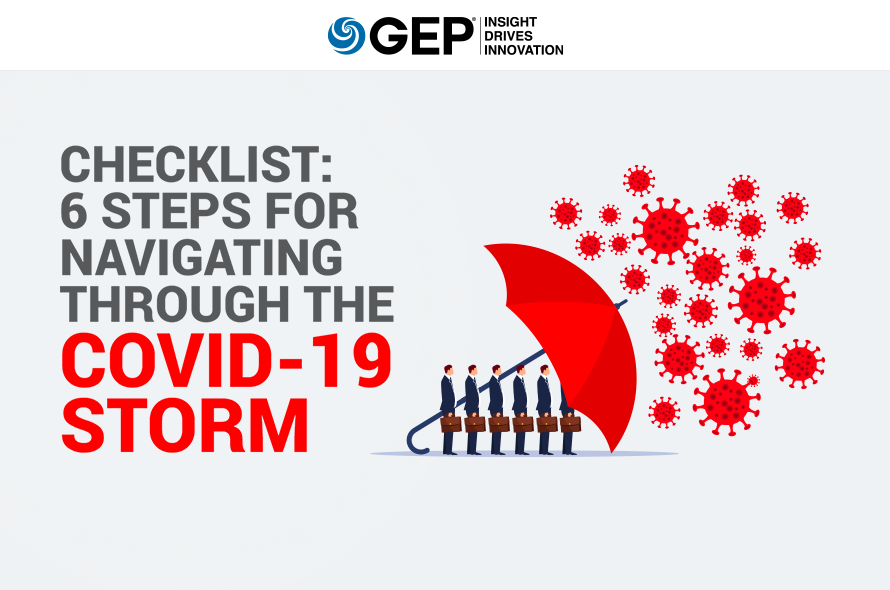Supply chains are in shock. Materials are stuck at borders. Outsourced services are shut down.
With revenues falling, companies are managing in unprecedented global chaos.
Leaders must align and navigate their procurement and supply chains right now.
Our latest blueprint for CV-19 contingency and cost containment is a detailed 6-point checklist that will help you capture all your risk and help isolate your recovery plan.
With 20 years of procurement and supply chain experience, GEP is uniquely positioned to help build targeted downturn and managed services strategies quickly and effectively.
Covid-19 has transformed from a short-term hiccup to a perfect storm at an unprecedented pace. It is normal to feel disoriented and to feel like you’re running in eight directions at once. The reality looks something like these two hypothetical but plausible scenarios:
A U.S.-based industrial manufacturer thinks that they are insulated from the impact to global supply networks. However, some of their raw materials come from Mexico and Canada where the borders are now closed. State and local regulations may impose closures on manufacturing sites. The government can also invoke the Defense Production Act to alter production in certain industries. The situation requires contingency plans be put into place quickly.
An E.U.-based services organization thinks that they are insulated because all of their personnel can work from home and they have no physical supply chain. However, their accounts payable function is outsourced to Asia and that provider is not set up to handle work-from-home for its employees – and AP work comes to a complete halt. As suppliers stop receiving payments, crucial outsourced services and technology will get interrupted resulting in major business disruption. This situation requires a contingency AP plan.
These scenarios are becoming the norm right now. Leaders who pull themselves together and align their organization to a well thought out plan to navigate through this storm will come out of it the strongest.
Here is GEP’s blueprint. While you may have thought through some of these items, this information can be used as a checklist to help organize your thoughts and capture all of your risk, contingency and recovery plans.
STEP 1: BATTEN DOWN THE HATCHES (1-2 WEEKS)
Identify potential disruptions and assess risks across all departments in parallel.
Checklist:
Legal
- Review customer contracts for commitments that may be at risk
- Provide guidance on applicability of Force Majeure
Procurement
- Review supplier contracts for BCP/DR commitments and last audit findings
- Review financial implications for key suppliers’ industries, identify risks
- Secure supply for items likely to go into short supply
Supply Chain Operations
- List out potential short-term disruptions expected from supply and identify alternatives
- Identify short to medium term demand pattern shifts
- Invoke adverse event activities in Demand Planning
Finance
- Review financial implications for own and customer industry
- Identify cost reduction targets to counter demand drops if any
HR
- Review flexible work arrangements
- Freeze non-essential hiring
- Prepare updates to travel and other policies as required
IT
- Prepare network and virtual capabilities to take increased load
- Invoke IT infrastructure BCPs internally and with suppliers
STEP 2: BUILD A WAR CHEST (1-2 WEEKS)
Preserve resources – personnel, technology and cash.
Checklist:
Cash
- Free up cash from non-core spending to deploy ‘keep-the-lights-on’ spending
- Update expense policies (travel, mobile devices, relocation, P-card, reimbursements, etc.) to impact spending immediately
- Add all relevant stop spending ideas
Personnel
- Evaluate departments that may have excess bandwidth (sales, marketing, R&D, facility management)
- Evaluate departments that will need extra bandwidth: supply chain, procurement, finance
- Redeploy resources where there is a skillset match
- Find external contingent labor or short-term managed services in procurement, supply chain and finance
Technology
- Enable or invest in virtual working infrastructure
- Evaluate office bandwidth requirements go down, but cloud bandwidth and compute requirements will increase
- Use tools that act as “control towers” to provide visibility and management over operations will be crucial, identify such tools in your system and ensure they are working well
STEP 3: SET UP THE CROW’S NEST (2 WEEKS)
Set up appropriate lead indicators correctly.
Let’s admit that none of us could really see this coming, and even when we did, we could not gauge the enormity of the impact. Currently, we are in a ‘fog of war’ with our indicators being news media and department briefings. This creates a risk that we may miss the recovery points as badly as we missed the downturn. The quicker we codify the inputs needed into data sources, the more clearly we can navigate through the evolving situation and take advantage of any recovery. These lead indicators should feed into a “manual control tower” which can eventually be replaced by technology solutions.
Suggested indicators are:
Demand Sensing
- Identify and track parameters that proxy demand in each segment including social media sentiment
Supply Constraints
- Closely monitor supply industry parameters to decide when to place new orders and resume production levels
Financial Indicators
- Monitor the financial health of the whole value chain from raw material producer to end user is important
Geo-Political Indicators
- Monitor COVID-19 peaks by country
- Monitor government actions to close and open borders
- Monitor changes in trade policy
STEP 4: STORM SAILS AND JERRY-RIGGING
Quick solutions for quickly emerging problems.
The normal command-and-control hierarchy, especially in large corporations, will not be nimble enough to navigate this storm. An alternate mechanism is needed. You need to focus people and resources.
Supply Chain Risk Assessment
- Create a dedicated, cross-functional team which can rapidly respond to changes in the lead indicators
- Empower the team to resolve point issues without time-consuming approvals, such as:
- Monitor and react to supplier shutdowns
- Monitor logistics disruptions and react on the spot
- Give a portion of the ‘war chest’ (resources and cash) to use at their disposal
STEP 5: ALLOW THE STORM TO PASS
Monitor the lead indicators closely and keep going until they point to a recovery.
Manufacturing needs to restart before the recovery actually hits the market in the form of demand. In the meantime, you should conduct and/or use:
Supply Chain Risk Assessment
- Keep monitoring the situation for supply risk
- Repeal the temporary measures imposed above as soon as it is feasible
Supply Risk Management Technology
- Make ongoing adjustments to spend policies, supplier relationships, contracts
STEP 6: WIND IN THE SAILS
Ride the recovery wave effectively by leveraging what you’ve learned.
If the above measures were put in place correctly, a portion of the cash war chest will remain unutilized. This should be spent judiciously to ensure a market-beating recovery. One use for this ‘war chest’ should be on acquisition of:
Underpriced Assets
- Vertically integrate with suppliers or acquire infrastructure from competitors
But there’s more to the recovery than assets alone. You’ll have to make the best use of what you have as well.
Optimization
- Optimize the distribution network for the new demand-supply landscape
- Integrate the indicators set up during step 3 into a sophisticated permanent demand sensing apparatus
- Set up a rapid sourcing program to renegotiate or set up new supply lines and take advantage of the new market dynamic
Technology
- Convert the “manual control tower” set up in step #3 into technology-driven solutions
Debt Reduction / Investment
- Deleverage, share buy-backs and other mechanisms to boost long-term financial strength

